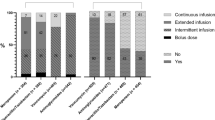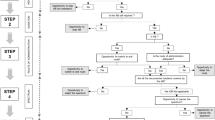Abstract
Background For amoxicillin-clavulanic acid and meropenem to be effective, concentrations must exceed the minimum inhibitory concentration of infecting pathogens. Objective To retrospectively evaluate time windows between both scheduled prescription and administration and reconstitution-preparation and end of administration of intravenous amoxicillin-clavulanic acid and meropenem prescriptions. Setting 37 hospital wards at a tertiary hospital, Belgium. Method All adult hospital stays with at least one amoxicillin-clavulanic acid or meropenem administration in 2018 were reviewed. Time windows were deemed acceptable if < 30 min between prescription and administration and < 90 or < 150 min between reconstitution-preparation and end of administration for amoxicillin-clavulanic acid and meropenem, respectively. Main outcome measure Time windows between prescription and administration and between reconstitution-preparation and administration. Results For 50 273 administered prescriptions, both time windows were acceptable in 53.7% of first dose and 56.4% of follow-up dose administrations. 43.7% of first doses did not respect the time window between reconstitution-preparation and administration (2.8%) or between prescription and administration (40.9%). These discrepancies equalled 11.1% and 26.3% for follow-up doses, respectively. Large variation across hospital wards was observed. After the first five consecutive administrations, 93.1% of patients had not received their antibiotics within the time windows allowed. The most striking predictor of timely administration with respect to both prescription and reconstitution-preparation time was prescription synchronisation with nursing administration rounds. Conclusion For amoxicillin-clavulanic acid and meropenem, timeliness of reconstitution-preparation and administration was appropriate in approximately half of administrations. Evaluating and safeguarding the timeliness of antibiotic administration should be considered an important aspect of antibiotic stewardship.




Similar content being viewed by others
Data availability
A data sample is available upon request. All SAS syntaxes are available upon request.
Reference
Houck PM, Bratzler DW, Nsa W, Ma A, Bartlett JG. Timing of antibiotic administration and outcomes for medicare patients hospitalized with community-acquired pneumonia. Arch Intern Med. 2004;164:637–44.
Puskarich MA, Trzeciak S, Shapiro NI, Arnold RC, Horton JM, Studnek JR, et al. Association between timing of antibiotic administration and mortality from septic shock in patients treated with a quantitative resuscitation protocol. Crit Care Med. 2011;39:2066–71.
Ko BS, Choi SH, Kang GH, Shin TG, Kim K, Jo YH, et al. Time to antibiotics and the outcome of patients with septic shock: a propensity score analysis. Am J Med. 2020;133:485–91.
Proulx N, Fréchette D, Toye B, Chan J, Kravcik S. Delays in the administration of antibiotics are associated with mortality from adult acute bacterial meningitis. Q J Med. 2005;98:291–8.
Kim RY, Ng AM, Persaud AK, Furmanek SP, Kothari YN, Price JD, et al. Antibiotic timing and outcomes in sepsis. Am J Med Sci. 2018;355:524–9.
Zhang D, Micek ST, Kollef MH. Time to appropriate antibiotic therapy is an independent determinant of postinfection ICU and hospital lengths of stay in patients with sepsis. Crit Care Med. 2015;43:2133–40.
Veiga RP, Paiva JA. Pharmacokinetics–pharmacodynamics issues relevant for the clinical use of beta-lactam antibiotics in critically ill patients. Crit Care. 2018;22:233–67.
Meng L, Mui E, Holubar MK, Deresinski SC. Comprehensive guidance for antibiotic dosing in obese adults. Pharmacotherapy. 2017;37:1415–31.
Ulldemolins M, Vaquer S, Llauradó-Serra M, Pontes C, Calvo G, Soy D, et al. Beta-lactam dosing in critically ill patients with septic shock and continuous renal replacement therapy. Crit Care. 2014;18:227–42.
Thabit AK, Hobbs ALV, Guzman OE, Shea KM. The pharmacodynamics of prolonged infusion β-lactams for the treatment of Pseudomonas aeruginosa infections: a systematic review. Clin Ther. 2019;41:2397-2415.e8.
Muller AE, Huttner B, Huttner A. Therapeutic drug monitoring of beta-lactams and other antibiotics in the intensive care unit: which agents, which patients and which infections? Drugs. 2018;78:439–51.
Van Wilder A, Spriet I, Van Eldere J, Peetermans WE, Vanhaecht K, Vandersmissen J, et al. Translating data from an electronic prescribing and medicines administration system into knowledge : application to doctor- translating data from an electronic prescribing and medicines. Med Care. 2020;58:83–9.
Carlier M, Verstraete AG, De Waele JJ, Stove V. Stability of amoxicillin and amoxicillin/clavulanic acid reconstituted in isotonic saline. J Chemother. 2016;29:54–6.
Electronic Medicines Compendium. Meronem IV 1g Powder for solution for injection or infusion - Summary of Product Characteristics (SmPC) - (emc) [Homepage on the Internet]. cited 2021 Feb 12. Available from: https://www.medicines.org.uk/emc/product/9834/smpc
Njoku K, Iyizoba Z. Is there a ‘Weekend Effect’ in the door to needle time of antibiotics administration in cancer patients presenting with suspected neutropenic sepsis. Clin Oncol. 2018;30:S2.
Benvenuti MA, An TJ, Mignemi ME, Martus JE, Thomsen IP, Schoenecker JG. Effects of antibiotic timing on culture results and clinical outcomes in pediatric musculoskeletal infection. J Pediatr Orthop. 2019;39:158–62.
Liu VX, Fielding-Singh V, Greene JD, Baker JM, Iwashyna TJ, Bhattacharya J, et al. The timing of early antibiotics and hospital mortality in sepsis. Am J Respir Crit Care Med. 2017;196:856–63.
Peltan ID, Brown SM, Bledsoe JR, Sorensen J, Samore MH, Allen TL, et al. ED door-to-antibiotic time and long-term mortality in sepsis. Chest. 2019;155:938–46.
Alsadoon A, Alhamwah M, Alomar B, Alsubaiel S, Almutairi AF, Vishwakarma RK, et al. Association of antibiotics administration timing with mortality in children with sepsis in a tertiary care hospital of a developing country. Front Pediatr. 2020;8:566.
Schmatz M, Srinivasan L, Grundmeier RW, Elci OU, Weiss SL, Masino AJ, et al. Surviving sepsis in a referral neonatal intensive care unit: association between time to antibiotic administration and in-hospital outcomes. J Pediatr. 2020;217:59-65.e1.
Lee JS, Giesler DL, Gellad WF, Fine MJ. Antibiotic therapy for adults hospitalized with community-acquired pneumonia a systematic review. JAMA. 2016;315:593–602.
Schouten JA, Hulscher MEJL, Natsch S, Kullberg BJ, Van Der Meer JWM, Grol RPTM. Barriers to optimal antibiotic use for community-acquired pneumonia at hospitals: a qualitative study. Qual Saf Heal Care. 2007;16:143–9.
Hulscher ME, Grol RP, van der Meer JW. Antibiotic prescribing in hospitals: a social and behavioural scientific approach. Lancet Infect Dis. 2010;10:167–75.
Institute for Safe Medication Practices. Acute Care Guidelines for Timely Administration of Scheduled Medications. [Homepage on the Internet] 2011. Cited 2021 Feb 12. Available from https://www.ismp.org/guidelines/timely-administration-scheduled-medications-acute
Institute for Safe Medication Practices. CMS 30-minute rule for drug administration needs revision. ISMP Medicat Saf Alert Acute Care. 2010;15:1–6.
Trossman S. 30-minute pressure cooker? ANA, nurses say multiple factors come into play with passing meds. Am Nurse. 2011;43:10–1.
Acknowledgements
The authors would like to express their gratitude to the IT department at University Hospitals Leuven, with in particular Karin Gilis and Pieter Vanautgaerden, for providing them with a workable dataset derived from the clinical work station at the hospital. In addition, the authors are thankful for Miss Abigail Moore, who proofread the manuscript.
Funding
None.
Author information
Authors and Affiliations
Corresponding author
Ethics declarations
Conflicts of interest
None.
Additional information
Publisher's Note
Springer Nature remains neutral with regard to jurisdictional claims in published maps and institutional affiliations.
Supplementary Information
Below is the link to the electronic supplementary material.
Rights and permissions
About this article
Cite this article
Van Wilder , A., Bruyneel, L., Decock, C. et al. Timeliness of administration of amoxicillin-clavulanic acid and meropenem in a large tertiary care centre. Int J Clin Pharm 43, 1651–1659 (2021). https://doi.org/10.1007/s11096-021-01297-0
Received:
Accepted:
Published:
Issue Date:
DOI: https://doi.org/10.1007/s11096-021-01297-0




